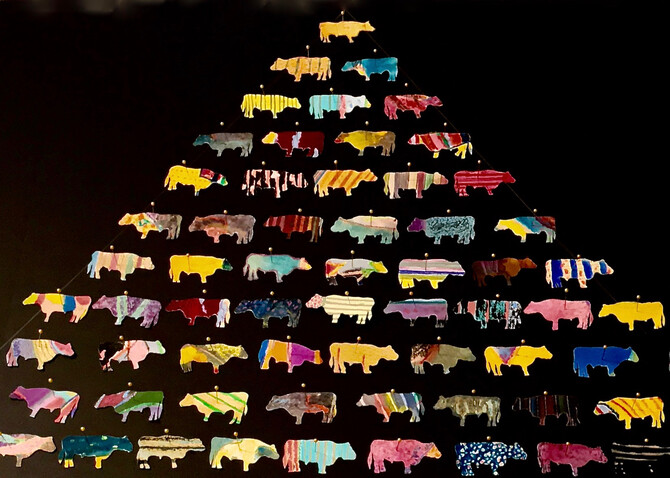Penn Vet Library Exhibit Explores the Human-Animal Connection Through Art
Eleanor Hubbard, an artist and University of Pennsylvania alumna, is a firm believer in the power of serendipity. Without it, her latest exhibition, “Natural Selection: Lost Cat, Found Ox and Other Inspiring Bonds,” would have never come to be. It is on display in the School of Veterinary Medicine’s Steven W. Atwood Library through May 16.
Hubbard’s colorful, evocative paintings, many of which were created for this exhibit on the iPhone’s Brushes app, feature 15 separate animals. Each work is accompanied by a brief narrative, written by the artist, describing salient details of the animals’ lives and those of the humans who came to care for them.
The seed for the show was planted at Hubbard’s class reunion in 2012, which she almost skipped. At the last minute, she was persuaded by her former college roommate to leave the American Academy in Rome, where she had been painting, to fly to Philadelphia for reunion weekend. Browsing the schedule of events, she saw a talk on the human-animal bond by James Serpell, the Marie A. Moore Professor of Ethics and Animal Welfare and director of the Center for the Interaction of Animals and Society at Penn Vet.
En route to Philadelphia Hubbard was invited to explore Mesolithic engravings in newly discovered caves outside Paris.
“Since Dr. Serpell began his lecture with cave art, I was riveted,” Hubbard said. “At the end I raised my hand to say that I had been painting an ox for several years and a strong bond had developed.”
The two spoke further following the lecture about bonds with unlikely animals and about her art.
“She has interesting ideas about how these animals become a kind of nexus for coincidental connections between disparate people, bringing them together in various ways,” Serpell said. “It does raise some intriguing questions about why some animals seem to have this effect, whether it’s something about the animal itself or an accident of circumstances.”
During that conversation the possibility of displaying her art at Penn was first raised, but busy schedules intervened and nothing more came of it for a few years.
Following last fall’s presidential election however, the artist found herself turning toward animal subjects and focusing on “the small miracles that go on every day, the quiet inexplicable kindnesses.”
A thought came to her: “Isn’t this the perfect time to create an exhibit of rescued animals, about how chance, great veterinarians, great people and luck cross paths?”
Recalling her 2012 conversation with Serpell, she called her own veterinarian on Martha’s Vineyard, who happens to be Steven Atwood, a Penn Vet alumnus and the benefactor for whom the school’s library is named.
Atwood put Hubbard in touch with librarian Margaret Lindem, who was encouraging but also shared that art could not be installed on the library’s glass walls. Fortunately, Hubbard’s husband, Geoffrey White, an architect and graduate of Penn’s School of Design, didn’t see that as an obstacle. He designed standing black easels to display paintings atop the library’s low bookshelves, a portable display.
Each work of art captures the story of a rescued creature. “Lucky,” portrays a canary Hubbard encountered during a haircut in Philadelphia’s Chestnut Hill neighborhood.
“One day I was sitting in the salon and a flash of yellow-orange flew by,” she said. A canary had flown in the salon’s open door along busy Germantown Avenue. By chance, as a teenager in Japan, the salon owner had held a job raising canaries. He knew a stressed and hungry bird would require sugar, so asked his assistant to get a bit of cake from a bakery across the street.
“This little guy ate it right up and revived,” said Hubbard. “For years Lucky was the salon’s well-named mascot but what had directed him to that specific door?”
Another cherished subject, appearing in a number of works, is a white ox. A woman living next to the farm where José was born had purchased the calf, sparing him from becoming a dinner plate feature in the restaurant she owned. Hubbard learned about the ox when his owner put an ad in the local paper, desperate to find a suitable home for the now 2,500-pound animal. Hubbard tried unsuccessfully to place him with a number of rescue organizations. By chance she relayed the story to friends in New York who responded they had just bought property in the Berkshires, enough acreage on which to keep an ox happy and healthy.
The artist began to visit their farm regularly to paint José in his new home. Among the works in “Natural Selection” is a display of 172 small watercolors of the ox. For this series Hubbard is creating a total of 6,089 paintings, one for each day of her model’s colorful life.
“We traveled to the Berkshires to see José the day before he died,” she said. “While unable to stand, he still just wanted to be loved and hugged.”
Chance, skilled veterinarians, caring people and luck created Natural Selection and all the characters involved.
The library, located on the second floor of Hill Pavilion, at 380 S. University Ave., is accessible Monday through Friday, 9 a.m. to 5 p.m. Photo identification is required for entrance to the building.
A percentage of sales of the limited-edition prints will benefit Penn Vet Student Scholarships.








